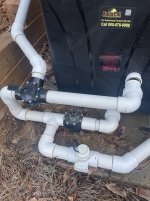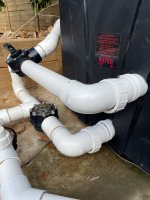I re-plumbed my pad this spring due to some construction that required the pad to move, and plumbed in a bypass for my heater, which it hadn't had before. Now that the temps are dropping, I'm using the bypass for the first time and am trying to winterize the heater (Aquacal). The instructions they provide say to use the bypass, then simply unscrew the unions to let the heater drain completely for a few days, then loosely reconnect them for the winter.
My issue is in the couple of days I've had it bypassed with the unions completely disconnected, I've noticed that the check valve does not completely keep water from going through, so water continues to occasionally leak out of the open union that leads to the heater output. I'm concerned that if I loosely reconnect the unions as the manufacturer suggests, some amount of water will continue to get past the check valve and into the heater, and potentially damage the heater during a freeze. (Atlanta area, so no extended deep freezes, but occasionally back to back days below freezing definitely possible.) On the other hand, if I don't reconnect the unions, I'll end up with water consistently draining out of the lines a little bit at a time and the pool level lowering as a result.
My question is, is this the way the check valve is supposed to work, or could mine be faulty? I've never used one before. I was under the impression it should prevent any water from going through "backwards." If it matters, I currently have my pump on at a pretty low speed (1600).
Thanks!

My issue is in the couple of days I've had it bypassed with the unions completely disconnected, I've noticed that the check valve does not completely keep water from going through, so water continues to occasionally leak out of the open union that leads to the heater output. I'm concerned that if I loosely reconnect the unions as the manufacturer suggests, some amount of water will continue to get past the check valve and into the heater, and potentially damage the heater during a freeze. (Atlanta area, so no extended deep freezes, but occasionally back to back days below freezing definitely possible.) On the other hand, if I don't reconnect the unions, I'll end up with water consistently draining out of the lines a little bit at a time and the pool level lowering as a result.
My question is, is this the way the check valve is supposed to work, or could mine be faulty? I've never used one before. I was under the impression it should prevent any water from going through "backwards." If it matters, I currently have my pump on at a pretty low speed (1600).
Thanks!



